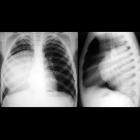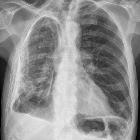pulmonary hydatid infection





























Pulmonary hydatid infection is a common manifestation of hydatid disease.
For a general discussion, and for links to other system specific manifestations, please refer to the article on hydatid disease.
Epidemiology
The lung is the second most common site of involvement with echinococcosis granulosus in adults after the liver (10-30% of cases), and the most common site in children . The coexistence of liver and lung disease is present in only 6% of patients .
Clinical presentation
When pulmonary hydatid cysts rupture and communicate with bronchioles, patients are described to cough up 'grape skin' like material .
Pathology
Thoracic involvement may occur via :
- transdiaphragmatic route (0.6-16% of cases of hepatic disease)
- haematogenous spread
Although the echinococcosis granulosus presents commonly with unilocular cysts, echinococcosis multilocularis and echinococcosis vogeli may cause alveolar and polycystic echinococcosis.
Radiographic features
CT
Generally, chest CT scan features include :
- multiple or solitary cystic lesion (most common)
- diameter of 1-20 cm
- unilateral or bilateral
- predominantly found in the lower lobes
Radiographic and CT features may differ in complicated and uncomplicated cysts.
Uncomplicated cysts are characterized by:
- round or oval masses with well-defined borders
- enhancement after contrast injection
- hypodense content relative to the capsule
Complicated cysts may show:
- meniscus sign or air crescent sign
- cumbo sign or onion peel sign
- water-lily sign
- consolidation adjacent to the cyst (ruptured cyst)
MRI
- T1: hypointense
- T2: hyperintense
The cyst capsule is hypointense on T2 weighted image (hypointense rim sign), isointense on T1 weighted images and shows mild postcontrast enhancement. The folded membranes within cyts are T2 hypointense .
Ultrasound
Double-layered wall in univesicular cysts and a double-layered septum in cases of multivesicular cysts ( wall sign)
Other less common thoracic hydatid manifestations include: invasion of the mediastinum , pericardium, chest wall , cardiovascular system, or inferior vena cava .
Siehe auch:
- Verkalkungen im Röntgenbild des Thorax
- Lungenzysten
- Echinokokkose
- Luftsichelzeichen
- Wasserlilien-Zeichen
- cumbo sign
- Lungenembolie durch Echinokokkose
und weiter:

 Assoziationen und Differentialdiagnosen zu Echinokokkose der Lunge:
Assoziationen und Differentialdiagnosen zu Echinokokkose der Lunge:





